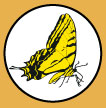We will spend most of the morning in the Patagonia Community Garden, Paton's Hummingbird Haven's butterfly garden, and a few other locations within town. Weather permitting, we will leave about noon and drive to Red Mountain Road for a very short walk and then to Harshaw Creek, which was flowing last Sunday with numerous puddle parties of Sulphurs and Oranges. There is limited parking at Paton's, so we may need to carpool to that location. There have been numerous reports of 40+ species seen in the Patagonia area in the last week, so expect abundant butterflies! When the field trip ends will be dependent on what we find and the possibility of afternoon thundershowers. It's going to be in the 90's by the end of the trip, so feel free to leave early if you need to do so. Bring plenty of water and insect repellent for chiggers, as well as your lunch if you plan to stay for the full field trip.
Photo: Carus Skipper (Polites carus) © Gerry Wolfe
It was a pleasant, sunny day - not too hot as building afternoon clouds helped keep the temperature down. We checked the community Garden, Paton's, a locat private garden, and the Post Office lantanas before a 2nd look at the Community Garden. After lunch in the park, we went to the "Black Hole" on Red Mtn Road and the culverts and "triangle area" of Harshaw Creek before ending the trip about 2:00 PM. We found a wonderful 52 species:
- Pipevine Swallowtail Battus philenor
- Checkered White Pontia protodice
- Cabbage White Pieris rapae
- Orange Sulphur Colias eurytheme
- Southern Dogface Colias cesonia
- Cloudless Sulphur Phoebis sennae
- Mexican Yellow Eurema mexicana
- Tailed Orange Eurema proterpia
- Sleepy Orange Eurema nicippe
- Dainty Sulphur Nathalis iole
- Gray Hairstreak Strymon melinus
- Leda Ministreak Ministrymon leda
- Western Pygmy-Blue Brephidium exile
- Marine Blue Leptotes marina
- Ceraunus Blue Hemiargus ceraunus
- Reakirt’s Blue Hemiargus isola
- ‘Echo’ Spring Azure Celastrina ladon
- Acmon Blue Plebejus acmon texana
- Fatal Metalmark Calephelis nemesis
- Palmer's Metalmark Apodemia palmeri
- American Snout Libytheana carinenta
- Gulf Fritillary Agraulis vanillae
- Variegated Fritillary Euptoieta claudia
- Mexican Fritillary Euptoieta hegesia
- Theona Checkerspot Chlosyne theona
- Bordered Patch Chlosyne lacinia
- Tiny Checkerspot Dymasia dymas
- Elada Checkerspot Texola elada
- Texan Crescent Phyciodes texana
- Painted Crescent Phyciodes picta
- Painted Lady Vanessa cardui
- Common Buckeye Junonia coenia
- Red-spotted Purple Limenitis arthemis astyanax
- Viceroy Limenitis archippus
- ‘Arizona’ California Sister Adelpha bredowii
- Queen Danaus gilippus
- Acacia Skipper Cogia hippalus
- Golden-headed Scallopwing Staphylus ceos
- Arizona Powdered-Skipper Systasea zampa
- Funereal Duskywing Erynnis funeralis
- White/Common Checkered-Skipper Pyrgus albescens/communis
- Desert Checkered-Skipper Pyrgus philetas
- Erichson's White-Skipper Heliopyrgus domicella
- Clouded Skipper Lerema accius
- Orange Skipperling Copaeodes aurantiacus
- Fiery Skipper Hylephila phyleus
- Carus Skipper Polites carus
- Sachem Atalopedes campestris
- Sheep Skipper Atrytonopsis edwardsii
- Nysa Roadside-Skipper Amblyscirtes nysa
- Dotted Roadside-Skipper Amblyscirtes eos
- Eufala Skipper Lerodea eufala
